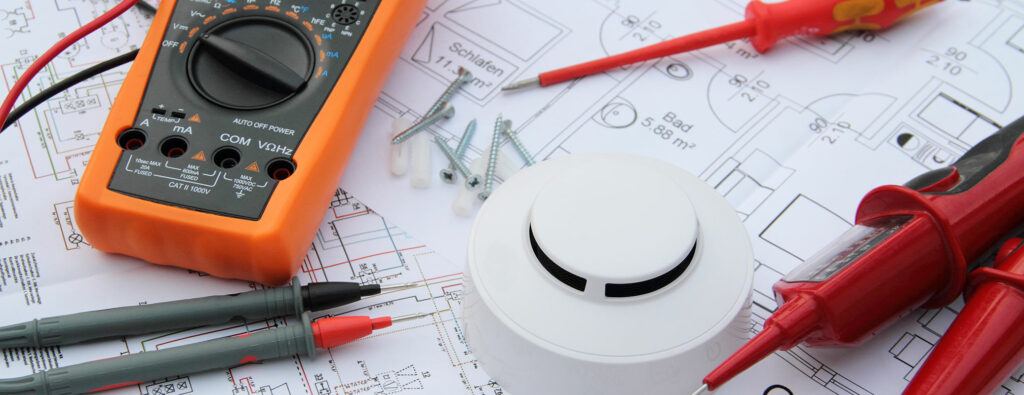The Ultimate Guide to Smoke Alarms For Your Home: Installation, Maintenance, Testing, and More
The danger of home fires has been made so very real to North Bay residents during this drought. Fire season is a very real thing, and seems to get longer each year. While that’s enough to worry about, many home fires start sans wildfire due to faulty wiring and other hazards in the home. Early detection matters, and can mean life or death. In this article, you’ll learn how many smoke alarms you need in your home, where to put them, what kinds are best, and what maintenance they need. We’ll also touch on carbon monoxide detectors.
How Many Smoke Detectors Do I Need?
According to the United States Department of Homeland Security, and the California Building Code, at least one smoke detector needs to be placed in each of the following areas of your home:
- On Every Floor Level
- In Every Bedroom
- In Every Hallway Outside of a Bedroom
- At the top of interior stairways
Following these guidelines will greatly improve your chances of surviving a home fire.
Where should they be installed?
Every level of your house needs to have at least one smoke alarm installed, whether people sleep there or not. That means basements and attics and everything in between, including the top of the stairs.
Non-sleeping Areas of the Home
When considering placement in non-sleeping areas, avoid placing within ten feet of any cooking appliance, or near drafts, ducts, or heating vents. Family rooms or other common rooms are good places, in addition to the bottom of an interior stairway. For the basement, the ceiling over the bottom of the basement stairs is recommended.
Bedrooms
Probably the most important location for a smoke alarm is in every bedroom. The kitchen and fireplace are not the only origins of home fires. Many house fires are caused by faulting wiring and other electrical issues, which could begin in a bedroom. In such a confined space, the sooner you are alerted the better.
Hallways Outside Bedrooms
Hallways that lead to bedrooms also need smoke alarms. This alerts sleepers to a house fire before the fire or smoke reaches their bedrooms.
How Often Should I Test My Home Smoke Alarms?
Smoke alarms should be tested monthly. Testing one is easy. Simply press the test button to make sure it sounds off. Remembering to do it may be the harder part. It might be helpful to set a reminder for yourself or do it on the first or last day of every month.
How Often Should I Replace the Batteries or My Smoke Detectors?
Smoke alarms vary, as do their batteries. Consult the manufacturer’s instructions for your model of smoke alarm for the exact type and/or brand of battery that is recommended for your unit. Straying from their recommendations could affect the performance of your smoke detector. The instructions will also advise how often the batteries should be replaced, which is usually once a year. However, Homeland Security recommends twice per year.
Some smoke detectors have lithium batteries that last 10 years. You will need to replace the entire unit, disposing of the old unit where you recycle expired batteries. In Sonoma County, you can put old batteries and your spent lithium smoke detector in a clear plastic bag on top of your recycle bin on garbage day.
All smoke alarms, regardless of battery type, or even if they are hard-wired with battery backup, should be replaced every 10 years.
What Do I Need to Look For in a Smoke Detector?
At the very least, a smoke alarm should come with the label of a recognized testing laboratory. If the alarm is hardwired, it needs to have a battery backup, ensuring that the batteries are replaced according to the manufacturer’s instructions.
For the best protection, the National Fire Protection Association (NFPA) recommends interconnected smoke detectors, to ensure everyone in the house is simultaneously alerted in the event of a fire.
What is an Interconnected Smoke Detector?
An interconnected smoke detector is like a smoke detector network. When your smoke alarms are interconnected, if the sensor on one is tripped, all the units will sound. The NFPA provides guidelines for installing these devices.
For instance, when installing one in the apex of a cathedral ceiling, it should be within three feet of the peak, but within the highest four inches. Also, all of the smoke alarms should be from the same manufacturer. For the best results, and greater peace of mind, have an experienced electrician install your interconnected smoke detectors.
Should I Have a Carbon Monoxide Detector in My Home?
Carbon monoxide (CO) is a potentially deadly gas that cannot be seen, smelled, or heard, which is why carbon monoxide detectors should be installed in every home.
Carbon monoxide results from the burning of many types of fuels, including wood, gas, oil, and propane. Unintentional carbon monoxide poisoning from sources other than fire, claims the lives of 400 Americans per year, according to the Centers for Disease Control. It also accounts for 20,000 emergency room visits and 4,000 hospitalizations every year.
These life-saving devices are needed for any home with fuel-burning appliances, including:
- Furnaces
- Water Heaters
- Ovens
- Stovetops
Even all-electric homes should install carbon monoxide detectors because CO can still come into the house from outside sources like a garage or backup generator.
Professional Smoke Detector Installation and Inspection in Sonoma County
As with any safety equipment, regular inspection is of paramount importance. An electrician can inspect, test, and perform repairs and replacements as needed for all of your smoke and carbon monoxide detectors. If your North Bay home does not have the required number of smoke alarms, or you would like your system of detectors tested or upgraded, Schaefer Electric Services can help.
The safety of your home and family is important to us. Let us give you the peace of mind of knowing that your family will be alerted in the event of a fire or dangerous levels of carbon monoxide. Contact us today for a free consultation for this or any other electrical need.



No comments yet. Add the first comment